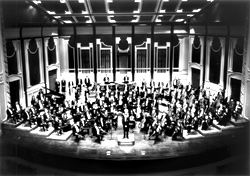For most of us, Jan. 1 is stock-taking resolution time, but for the classical music world, aside from the summer festivals, the new year starts in September. So, as vacation begins, now might be a good time to air a few of my concertgoing pet peeves—offenders will have three months to institute reforms. I’ll bet these aren’t just my complaints, either; chat up some of those people who don’t do classical music and see which of the following initiatives might lure them into the concert hall.
Ditch the tuxes. For gala season- opener concerts, New Year’s Eve, and the like, OK, maybe, just because it’s fun to play dress-up once in a while. But for everyday concerts, the formality of tuxes is a hindrance, reinforcing stereotypes of stuffiness and putting off newbies. If an ensemble’s repertory and playing in themselves don’t impress, something’s wrong; musicians shouldn’t need to trick audiences into taking them seriously by dressing as if they’ve all been invited to a late-night champagne supper at Noel Coward’s. Seattle Symphony men wear black suits, not tuxes, for Friday afternoon concerts, and the audience isn’t markedly less attentive. Visual uniformity is no excuse; SSO women wear whatever black clothes they like—pants, dresses, or skirts, spangly or subdued. And for community orchestras playing a suite from Carmen at a high school, formal wear is just plain pretentious. My suggestion: black pants or skirts with shirts in some eye-soothing shade that would harmonize with the browns and golds of the instruments.
Put timings in the program. They’re ubiquitous on CD cases—why not include them in concert programs? It helps to know whether an unfamiliar piece is going to be four minutes long or 34. How do you justify not letting your audience know this?
Shorter intermissions. In general, audiences get more downtime than they need, inducing restlessness no matter how lavishly the coffee and cookies flow. Do musicians need so much? Intermissions should be, let’s say, between one-quarter and one-fifth the length of a concert’s first half. A memorably extreme and irritating case of intermission inflation occurred during San Francisco Opera’s Otello a few seasons ago: four acts, none over 40 minutes, but interspersed with three full half-hour intermissions. A two-CD opera which lasted from 8 p.m. to midnight. Could the set changes really have been so elaborate and time-consuming? Or were they just manipulating us into getting bored enough to buy a $9 glass of wine?
Shorter new-music concerts. I applaud the inclusiveness, giving as many composers as possible their moment—but most new-music events are about one piece too long. Unfamiliar music requires (and deserves) more concentration from even the most enthusiastic and experienced listeners; do the composers a service by not burning the audience out.
Develop a better visual sense. A personal note from the journalism front: If you want newspaper coverage, come up with better photos. The standard 8×10 glossy head shot looks terrible in black-and-white, one column wide. Not just for us music writers, who have to apologize to our editors with some regularity (“Yeah, I know it’s a crappy photo, but it really is the most interesting concert of the week . . . “), but for the sake of building audiences. Classical ensembles are competing for attention against theater and dance troupes, who generate great rehearsal action shots, and pop musicians, who also pay attention to visuals. Take a cue from them. Eye-catching posters, season brochures, and program covers are rare in this town. And who came up with the standard program layout cliché of titles left-justified and composer names right-justified across the page from each other? It’s hard to read. Do something else.
Though musical quality is obviously top priority, all these details matter, too. Byron Schenkman once confided that one of his motivations for starting Seattle Baroque was that he was tired of the bad old style of early-music presentation: distant academics shambling onstage in Birkenstocks. And indeed combining polish and professionalism with welcoming informality and intimacy has been one of the ensemble’s hallmarks, earning it a devoted fan base. Other examples abound, from the Seattle Chamber Music Society to the Esoterics, of groups who take pains to put on an inviting public face. Seattleites are hungry for music—don’t give them reasons to stay away.







